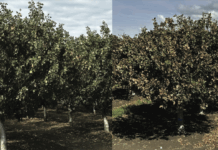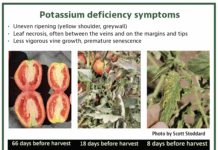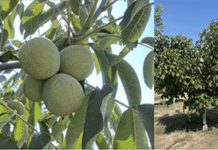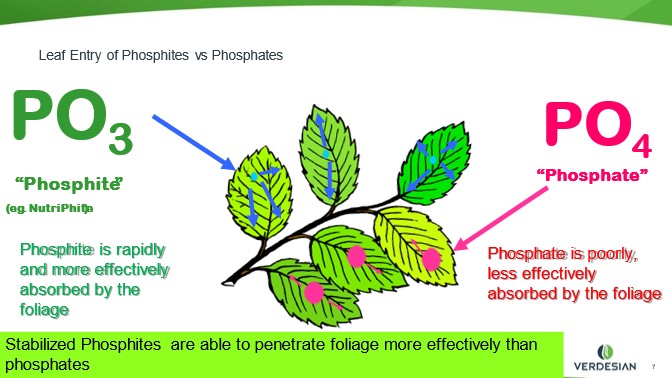Phosphite has been a controversial topic for years. Its use and benefits are argued in hundreds of research papers across the world’s scientific communities. Is it a fertilizer, a biostimulant or a fungicide? These questions are discussed in multiple university research results. I believe if we look carefully, we can conclude phosphite serves all three functions. As with everything we do with chemicals and nutrition, we need to be aware of possible negative effects. We also need to determine how we are using the phosphite materials and the results we are seeking.
Phosphite (PO33-; Phi), a reduced form of phosphate (PO43-; Pi), is widely marketed as either a fungicide or fertilizer or sometimes as a biostimulant. Because crop consultants, growers and distributors see the product marketed in all three ways, it can cause confusion. Each designated use will most likely be tied to the phenology (growth stage) of each treated crop. Timing is critical to determine which effect we are seeking. We have addressed phosphite in a nutrition role in Part One of this article series. Part Two spoke of Phi in terms of a biostimulant. In this article, we broach the controversial topic of Phi as a fungicide.
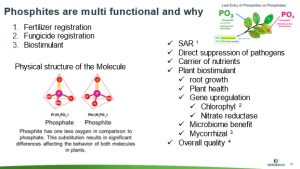
Usage
Phi salts can be used as a biodegradable fungicide to protect plants against Phytophthora dieback. It is usually applied as potassium phosphite, derived from phosphorus acid neutralized with potassium hydroxide. Calcium and magnesium phosphite may also be used. One way Phi works is by boosting the plant’s own natural defenses and thereby allowing susceptible plants to survive within Phytophthora dieback infested sites. It is important to note there is no treatment that will eradicate Phytophthora dieback.
Phi can enhance plant health directly through control of selected fungi on cultivated or native plants. In general, Phi acts as a priming agent of several plant defense responses. Excellent reviews on the use of Phi to control or reduce the severity of selected plant diseases have been published. Phi-based fungicides often are labeled as fertilizers because of significantly less complex and costly regulatory approval processes required for fertilizers compared to fungicides. Use of Phi as a fungicide is primarily targeted to control of oomycete pathogens like those of Phytophthora but has been shown to control many others. In studies, growth of a Phi-sensitive strain was inhibited regardless of phosphorus supply, whereas resistant strains were inhibited by Phi only under low Pi levels. Phi is effective in controlling root and crown rot caused by Phytophthora, and researchers reported a linear reduction in the severity of downy mildew and a significant improvement in soybean with an increase. Significant Phi control of Phytophthora disease in citrus may be achieved through both soil and foliar applications. Soil-applied Phi was more effective in controlling citrus root rot. In addition, some nematode control has been documented.
The concentration of Phi at the infection site is key.
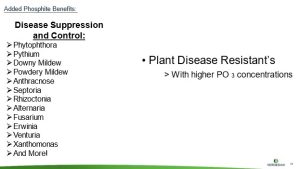
At lower levels of concentration, antifungal metabolism can be triggered, and at higher concentration, Phi can inhibit fungal growth. Ink disease in walnuts was significantly reduced through some treatment methods. Foliar-applied Phi has been successful in controlling pecan scab. Phi has also shown it can be effective in crown rot on peppers. Fungicides containing Phi can suppress foliar and soilborne diseases. With foliar diseases, repeated applications are frequently needed as Phi should be present at the time infection occurs. In contrast to non-systemic fungicides (e.g., mancozeb) labeled for oomycetes, Phi is readily translocated throughout the plant, which is especially advantageous for disease control in potato tubers and other underground plant tissue in potatoes. Phi has been foliar applied during the growing season or sprayed on potatoes after harvest both with excellent fungal disease control.
Interestingly, phosphite has been shown effective against summer decline in creeping bent grass by pythium. Root and shoot growth improvements have been observed in turf management along with good control on dollar spot. Additionally, positive control of pythium in bluegrass was observed. Pythium blight suppression due to Phi treatments on perennial ryegrass and creeping bent grass and anthracnose basal rot on an annual bluegrass were reported.
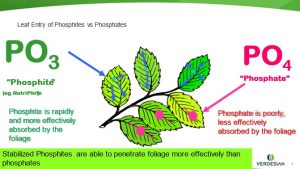
Disease Control Spans Wide
The benefits of Phi in the control of numerous diseases have been researched for years. The number of research reports is too numerous to go into in a short review. I encourage PCAs to research this effective tool on their own and find the fit in the crops they manage. We need every tool at our disposal, and Phi is proven to be effective through research. I caution to use Phi products correctly and beware as all are not created equal. Without special stabilization, they do not mix well with metal micronutrients or metal-containing fungicides and pesticides. There is currently technology that allows you to mix phosphites safely and effectively. Go to the following website to learn more about the special patented technology that can stabilize your phosphite and allow safe tank mixing and complete efficacy of applied products: vlsci.com/products/nutri-phite/.
Controls that have been reported:
- Apple Mouldy core, Alternaria alternate
- Avacado Dieback, Phytophthora cinnamomi
- Banksia Dieback, Phytophthora cinnamomi
- Bentgrass Summer decline, Pythium
- Cabbage Clubroot, Plasmodiophora brassicae
- Chestnut Ink disease, Phytophthora cambivora
- Cucumber Damping-off, Pythium ultimum
- Grape Downy mildew, Plasmopara viticola
- Lupin Dieback, Phytophthora cinnamomi
- Maize Downy mildew, Peronosclerospora sorghi
- Orange Brown rot, Phytophthora citrophthora
- Papaya Fruit rot, Phytophthora palmivora
- Pecan Scab, Fusicladium effusum
- Pepper Crown and root rot, Phytophthora capsici
- Potato Late blight, Phytophthora infestans
- Potato Pink rot, Phytophthora erythroseptica
- Potato Bacterial soft rot, Erwinia carotovora
- Soybean Downey mildew, Peronospora manshurica
- Strawberry Leather rot, Phytophthora cactorum
- Tangelo Brown spot, Alternaria alternata
- Tobacco Black shank, Phytophthora nicotiana
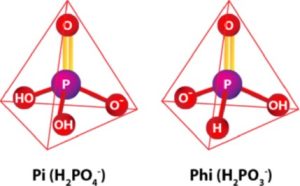
References
Understanding the Phosphonate Products – Penn State Extension
extension.psu.edu
Jan 1, 2023 … Phosphonate fungicides and fertilizers are absorbed by plants and incorporated into cells as phosphite ions (H2PO3-). The fact that this ion …
Phosphites Fungicide Products for Golf Courses
www.golfventures.com
Phosphite treatments works by boosting the turf grasses own natural defenses and thereby allowing susceptible plants to survive infections. Most turfgrass …
Review of Phosphite as a Plant Nutrient and Fungicide – MDPI
www.mdpi.com
Aug 30, 2021 … Phosphite (Phi)-containing products are marketed for their antifungal and nutritional value. Substantial evidence of the anti-fungal …
Phosphite (Phosphonate) fungicide treatment – Chemjet
www.chemjet.co.uk
Phosphite salts can be used as a biodegradable fungicide to protect plants against Phytophthora dieback. It is usually applied as potassium phosphite, …
Study 1: Phosphite fungicides and fertilizers and contact fungicides
www.gcmonline.com
Not applicable phosphite standard phosphorous acid potassium phosphite. 70.5 grams/liter. 30.9 fluid ounces. 0.17. Acros Organics. Not applicable.
Understanding the Phosphonate Products – Penn State Plant
d2j31icv6dlhz6.cloudfront.net group of turfgrass products known as phosphonates (potassium phosphite, phosphorous … Phosphonate fungicides and fertilizers are absorbed by plants and …
Clarification on Phosphite Materials | UGA Pecan Extension
site.extension.uga.edu
Mar 23, 2020 … Dr. Tim Brenneman first began testing phosphite materials on pecan primarily … should be tank mixed with another fungicide for nut scab.
Association phosphite x fungicide: protection against powdery …
link.springer.com
Mar 22, 2022 … Phosphite-based formulations are used as fungicides, biostimulants, and fertilizers (Gómez-Merino and Trejo-Téllezb 2015). Phosphites can act …
Phosphite (phosphorous acid): Fungicide, fertilizer or bio-stimulator?
www.tandfonline.com
Phosphite (Phi), a reduced form of phosphate (Pi), is widely marketed as either a fungicide or fertilizer or sometimes as a biostimulant. This is …
Phosphites For Lawns – Fertilizer Or Fungicide? – YouTube
www.youtube.com
Jul 15, 2021 … Phosphites garner wide acclaim in the professional turfgrass world; however, with their appearance in lawn care – a series of questions …




